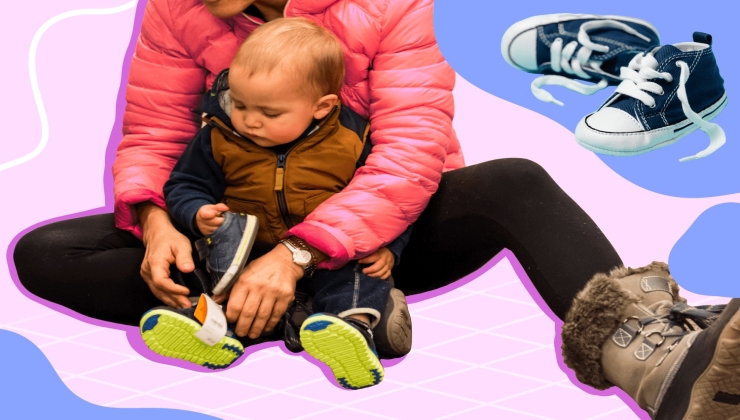Have you ever struggled to find the perfect pair of baby shoes for your little one? Whether you’re a new parent or just looking to update your child’s footwear collection, navigating the world of baby shoes can be overwhelming. This comprehensive guide will discuss everything you need to know about buying baby shoes.
Types of Baby Shoes
There are different types of baby shoes designed for infants and toddlers. Here are some common types:
Soft-Soled Shoes
Soft-soled shoes are specially designed for newborns and infants who are not yet walking. These shoes have flexible and lightweight soles, allowing the baby’s feet to move naturally.
Pre-Walkers
Pre-walkers are shoes designed for babies starting to take their first steps but not yet full-fledged walkers. These shoes typically feature a soft and flexible sole, providing support and stability as the baby begins to explore walking. Pre-walkers often have a secure closure system, such as Velcro straps or elastic laces, to keep the shoes in place during these initial walking attempts.
First Walkers
First walkers are shoes crafted for toddlers who have gained confidence in walking independently. These shoes have sturdier soles than pre-walkers, providing more support for the growing feet.
In addition, first walkers come in various styles, including sneakers, sandals, and boots. They often feature additional features like reinforced toe caps and adjustable closures to accommodate the toddler’s active movements.
Winter and Summer Shoes
Winter shoes are designed to keep little feet warm and protected from cold temperatures. They often come with insulation and water-resistant materials.
On the other hand, summer shoes are breathable and lightweight to keep the baby’s feet cool during warmer months. Sandals and open-toe designs are popular choices for summer, allowing for air circulation.
Factors to Consider When Buying Baby Shoes
When buying baby shoes, there are a few important factors to consider, such as:
Material and Breathability
When buying baby shoes, consider the material and breathability to keep little feet comfortable. Opt for soft and breathable materials like cotton or leather. Breathable shoes help prevent overheating and keep the baby’s feet dry. This is especially important as babies’ feet can sweat, and proper ventilation is crucial for their comfort.
Support and Flexibility
Look for shoes that provide support while allowing flexibility for natural movement. Babies’ feet are still developing, so shoes with flexible soles help in proper foot development. However, ensure that the shoes provide support around the ankle and arch without being too rigid. This balance between support and flexibility is essential for aiding the baby’s early steps.
Easy to Put On and Take Off
Babies are known for their wiggly toes, making getting shoes on a bit challenging. For shoes, look for ones that have closures that you can change, like Velcro straps or elastic laces. This feature makes dressing and undressing little feet a hassle-free experience for both parents and babies.
Safety Features
Prioritize safety features when selecting baby shoes. Opt for shoes with non-slip soles to prevent slips and falls, especially as your baby starts to explore walking. If needed, check for rounded toe boxes that provide ample space for tiny toes to move comfortably.
Additionally, ensure that no small parts could pose a choking hazard. Safety is paramount; choosing shoes with these features promotes a secure and risk-free environment for your baby.
Tips for Buying Baby Shoes
When buying baby shoes, here are some simple tips to keep in mind:
1. Shop for Shoes in the Afternoon
Choosing the right time to shop for baby shoes can make a difference. It’s best to shop in the afternoon when your baby’s feet may be slightly more significant due to daily activities. This ensures that the shoes you pick provide a comfortable fit throughout the day, avoiding any discomfort caused by shoes that might feel snug later on.
2. Check for Proper Fit
Ensuring a proper fit is crucial when buying baby shoes. With that, measure your baby’s feet regularly, as their size can change quickly during the early years. Look for shoes that match the length and width of your baby’s feet. A snug yet not too tight fit around the heel and instep provides the necessary support for growing feet.
3. Allow Room for Growth
Babies grow at a rapid pace, and their feet are no exception. When buying shoes, leave a little room for growth. Aim for about a thumb’s width of space between the longest toe and the front of the shoe. This allowance ensures that the shoes accommodate your baby’s developing feet and won’t become too tight as they grow.
4. Consider the Ease of Cleaning
Babies are known for their messy adventures, so considering the ease of cleaning is practical. Opt for shoes made from materials that are easy to wipe clean or toss in the washing machine. This ensures that the shoes remain hygienic and maintain their appearance even after encounters with spills and playtime messes.
Get Your Baby the Best Baby Shoes Today
Whether it’s those first tentative steps or simply keeping those tiny toes snug, the right pair of baby shoes enhances every precious moment.
As you navigate the world of adorable footwear, it’s time to embark on the next step: getting your baby the best shoes that encapsulate comfort, style, and safety. Your little one’s journey is as unique as their tiny footsteps, and with the right shoes, each stride becomes a cherished memory.

